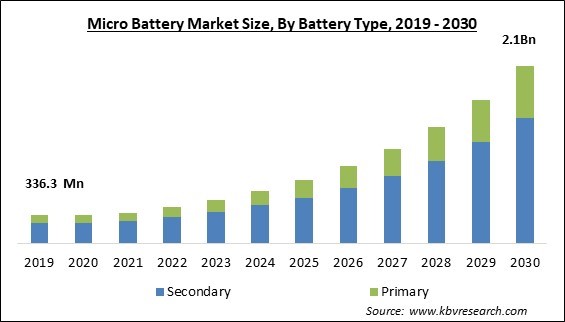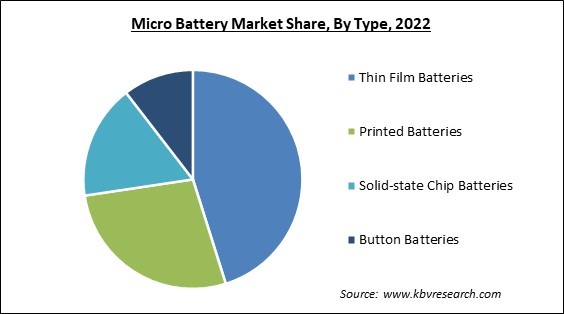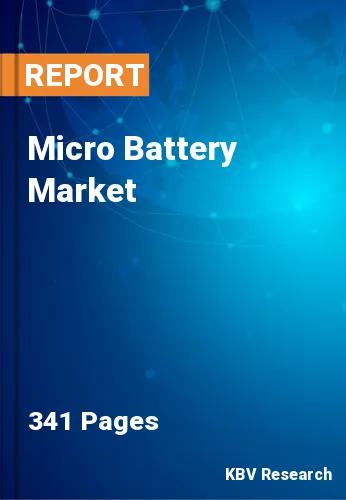The Global Micro Battery Market size is expected to reach $2.1 billion by 2030, rising at a market growth of 22.2% CAGR during the forecast period.
Button batteries are broadly used in small electronic devices including watches, microphones, and handy remote controllers. Therefore, the button batteries segment would capture approximately 1/5th share of the market by 2030. As a common power source for calculators, key fobs, and hearing aids, button batteries are found in various consumer electronics products. They are extremely suitable for these portable electronic devices due to their small size and ability to provide a constant power supply. Additionally, the healthcare industry significantly influences the demand for button batteries. They are widely used in medical devices like glucose meters, thermometers, and pacemakers. Medical applications that require consistent, uninterrupted power rely heavily on button batteries' long shelf life and dependable performance. Some of the factors impacting the market are increasing demand for wearable devices, increasing usage of wireless sensors integrated with micro batteries, and lack of specifications for micro battery designs.

Wearable devices include wristwear like smartwatches & fitness bands, eyewear like smart glasses, and wearable virtual reality headsets. The majority of wearable applications require ultra-thin durable batteries. With new product introductions and developments, wearable technology is experiencing increased product innovation. As a result, thin film and printed batteries can be integrated to create wearable devices with tremendous flexibility and an ultra-thin design. In light of this, the rising adoption of wearable technology is estimated to result in the growth of the market. The developments in IoT and wireless sensor technology have accelerated the adoption of wireless sensors. Micro batteries are rapidly becoming a viable power supply option for embedded system designers, facilitating the use of wireless sensors in previously impossible applications. Due to their ultra-thin profile and low leakage characteristics, these batteries are perfect for energy-harvesting devices. The growing popularity of energy-harvesting-based autonomous wireless sensors is anticipated to boost this market.
However, the proprietary technology used to produce micro batteries varies by manufacturer and depends on the manufacturer's specifications. Because these micro batteries are made exclusively for various electrical devices, compatibility concerns may exist if used with others. Because of the lack of uniformity, there may be safety concerns, such as an increased chance of overheating, short circuits, or even battery failures, which could harm equipment or endanger people. This factor poses a challenge for this market.
By battery type, the market is divided into primary and secondary. In 2022, the secondary segment dominated the market with the maximum revenue share. The demand for extended battery life, environmentally friendly batteries, and batteries that are more cost-effective than primary batteries are the main drivers of this market's expansion. Rechargeable batteries are another name for secondary batteries. These rechargeable batteries can be charged by plugging them into a power source, like a USB port.
Based on type, the market is bifurcated into thin film batteries, printed batteries, solid-state chip batteries, and button batteries. In 2022, the printed batteries segment garnered a significant revenue share in the market. Materials including zinc dioxide, manganese dioxide, zinc chloride, and carbon zinc are used to make printed batteries. Compared to conventional or thin-film batteries, these materials are less expensive than lithium chemistries. Printed batteries are created using a screen-printing technique to print the electrodes over a paper or plastic film substrate, then laminate the electrolytes between those electrodes.

By material, the market is classified into alkaline, silver oxide, lithium and others. In 2022, the lithium segment witnessed the largest revenue share in the market. Typically, lithium-ion cells are used to create micro batteries. Due to their high energy density, lithium-ion batteries are able to store a significant quantity of energy in a very small volume. Additionally, lithium-ion batteries have a low rate of self-discharge, which prevents them from losing their charge over time.
Based on application, the market is segmented into consumer electronics, medical devices, smart packaging, smart cards, wireless sensors, and others. In 2022, the consumer electronics segment acquired a substantial revenue share in the market. Consumer electronics products like wearables, calculators, remote controls, and low-drain devices increasingly use micro batteries. The use of thin film, printed, coin/button, and solid-state chip batteries in consumer electronics is driven by the miniaturization of electronic products and the demand for flexible electronics. Thin film batteries can power portable consumer electronics.
On the basis of capacity, the market is fragmented into below 10 mAh, 10 to 100 mAh and above 100 mAh. In 2022, the 10 to 100 mAh segment witnessed the largest revenue share in the market. Small sensors, remote controls, some wearable technology, and other portable devices can all be powered by micro batteries with this capacity range because of their adaptability. Low-power applications require micro batteries with a capacity between 10 and 100 mAh, which ensure an effective power supply and little energy waste.
| Report Attribute | Details |
|---|---|
| Market size value in 2022 | USD 432.4 Million |
| Market size forecast in 2030 | USD 2.1 Billion |
| Base Year | 2022 |
| Historical Period | 2019 to 2021 |
| Forecast Period | 2023 to 2030 |
| Revenue Growth Rate | CAGR of 22.2% from 2023 to 2030 |
| Number of Pages | 341 |
| Number of Table | 560 |
| Report coverage | Market Trends, Revenue Estimation and Forecast, Segmentation Analysis, Regional and Country Breakdown, Companies Strategic Developments, Company Profiling |
| Segments covered | Battery Type, Type, Material, Application, Capacity, Region |
| Country scope | US, Canada, Mexico, Germany, UK, France, Russia, Spain, Italy, China, Japan, India, South Korea, Singapore, Malaysia, Brazil, Argentina, UAE, Saudi Arabia, South Africa, Nigeria |
| Growth Drivers |
|
| Restraints |
|
Region wise, the market is analyzed across North America, Europe, Asia Pacific, and LAMEA. In 2022, the North America region led the market by generating the highest revenue share. The demand for IoT devices and portable consumer electronics is growing, especially in developing nations like China, India, Japan, and South Korea. In this region, the use of next-generation smart cards is rising quickly. The demand for flexible batteries in smart cards has surged due to all this. Due to the demand for wearable devices, consumer electronics, and smart packaging from the key nations in this region, this market in the Asia Pacific is anticipated to expand.
Free Valuable Insights: Global Micro Battery Market size to reach USD 2.1 Billion by 2030
The market research report covers the analysis of key stake holders of the market. Key companies profiled in the report include Panasonic Holdings Corporation, VARTA AG, Murata Manufacturing Co., Ltd., TDK Corporation, Berkshire Hathaway, Inc. (Duracell, Inc.), Ultralife Corporation, Maxwell Technologies (UCAP Power, Inc.), Cymbet Corporation, Enfucell Oy, Koch Industries, Inc. (Molex LLC).
By Battery Type
By Type
By Material
By Application
By Capacity
By Geography
The Market size is projected to reach USD 2.1 billion by 2030.
Increasing Use of Wireless Sensors Integrated with Micro Batteries are driving the Market in coming years, however, Lack of Specifications for Micro Battery Designs restraints the growth of the Market.
Panasonic Holdings Corporation, VARTA AG, Murata Manufacturing Co., Ltd., TDK Corporation, Berkshire Hathaway, Inc. (Duracell, Inc.), Ultralife Corporation, Maxwell Technologies (UCAP Power, Inc.), Cymbet Corporation, Enfucell Oy, Koch Industries, Inc. (Molex LLC).
The Medical Devices segment acquired maximum revenue share in the Global Micro Battery Market by Application in 2022; thereby, achieving a market value of $594.5 million by 2030.
The Thin Film Batteries segment is leading the Market by Type in 2022; thereby, achieving a market value of $908.3 million by 2030.
The Asia Pacific region dominated the Market by Region in 2022, and would continue to be a dominant market till 2030; thereby, achieving a market value of $760.3 million by 2030.
Our team of dedicated experts can provide you with attractive expansion opportunities for your business.

